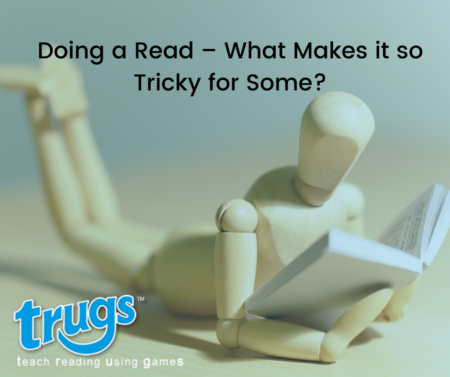If only ‘doing a read’ was as simple as it sounds. We often take for granted that the children and young people that we support will have the skills to make the words on a page magically travel through their eyes, into their brains and be spoken accurately from their mouths whilst simultaneously making meaning and then responding. In reality, what actually happens is a complex multistep process with many things happening at the same time. When we ‘do a read’ we have to (and I bet that I have not covered everything here) track and point with our eyes, draw on our memory to make links for meaning and to retrieve letters, whole words and sounds, filter out distractors, keep our place, move our lips and tongue to make the correct shapes to form the sounds to make words, cross check our decoding with a range of cues including the illustrations, apply our understanding of print conventions and concepts, listen to our selves reading and make corrections by deploying a range of decoding strategies…
I could go on!
If we then add into the mix the complexities of the English language with all of its rules, exceptions and conventions with what could be argued is a generally challenging orthography we can begin to understand why decoding the words to make meaning can be so challenging! We must also remember that humans aren’t naturally ‘wired’ for reading – we do speech.
For those that find reading challenging the Matthew Effect becomes a very relevant issue. If not addressed, a lack of reading skills can become an educational disadvantage. The Matthew Effect is a bible reference in which the rich get richer whilst the poor get poorer – an ever widening gap. For reading, the Matthew Effect is not only about the progressive learning decline of those who struggle to acquire reading skills but also about the barriers to learning that a lack of reading skills will pose. A potential progress and achievement gap that will continue to widen which will ultimately hinder access to education and could be life chance limiting.
If we don’t like how something feels or find it frustratingly difficult we tend to choose not to do it (this is me with the dentist). If a child does not enjoy reading they will, ultimately, opt out. This leads to lack of rehearsal of crucial early reading skills and an absence of automaticity. Reading begins to become increasingly more unpleasant impacting upon motivation to read, vocabulary growth slows down which creates a barrier to learning in the classroom and potentially school becomes an unpleasant experience.
For me, reading is one of the greatest gifts that we can give our children and young people. Beautifully written fiction allows us the luxury of being transported to alternative realities, to meet new characters, visit faraway lands and discover new words. Non-fiction helps us to expand our thinking, ask and answer questions and grow as we explore our personal passions and perhaps learn something new. Reading really is the key to new knowledge and the wider knowledge outside of our classrooms. It is therefore our responsibility as educators to ensure that all of our children have the tools that they need to make print accessible. By unlocking reading, we have the power to give them the keys to the world!
So what so we do? Here are ten ideas:
- We need to find the fun so that reading feels good. Games, word puzzles, joke books, reading clues for treasure hunts…anything that prompts a smile and a belly laugh.
- Focusing on reading using a dripping tap approach – rehearse little and often.
- Spotting environmental print.
- Offering choices linked to personal choices such as web pages, jokes, leaflets, favourite authors the back of a cereal packet… Most children don’t hate reading, they just have not yet found the right text. We need to help them find their hook.
- Model – our children need to see us reading and we need to think aloud about what and how we read to make the invisible process of reading visible.
- Teach a buffet of decoding strategies including phonics, whole word recognition and a range of cross checking strategies.
- Give reading real purpose in a print rich environment.
- Put the subtitles on whilst watching television.
- Offer audio books with the paper copy to read along with.
- Value and make reading inviting– provide special reading time and make it special with hot chocolate and a cosy reading space.
Written by Beccie Hawes – Head of Service at Cadmus Inclusive

